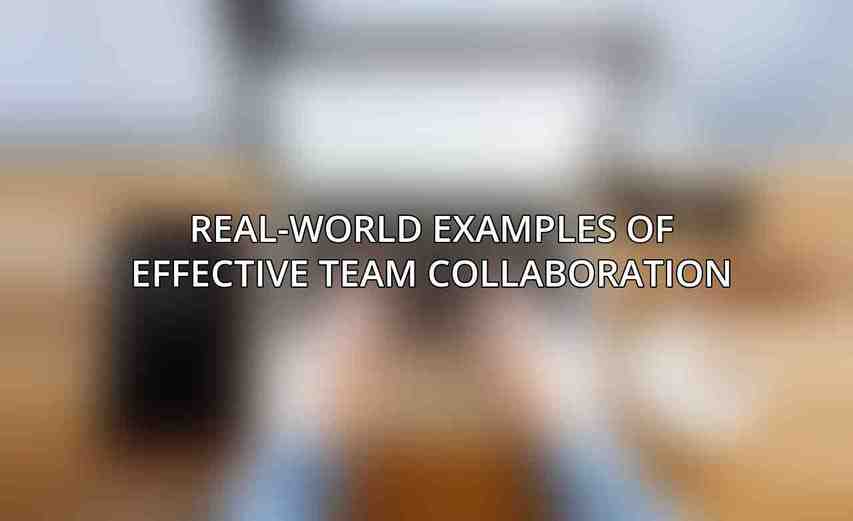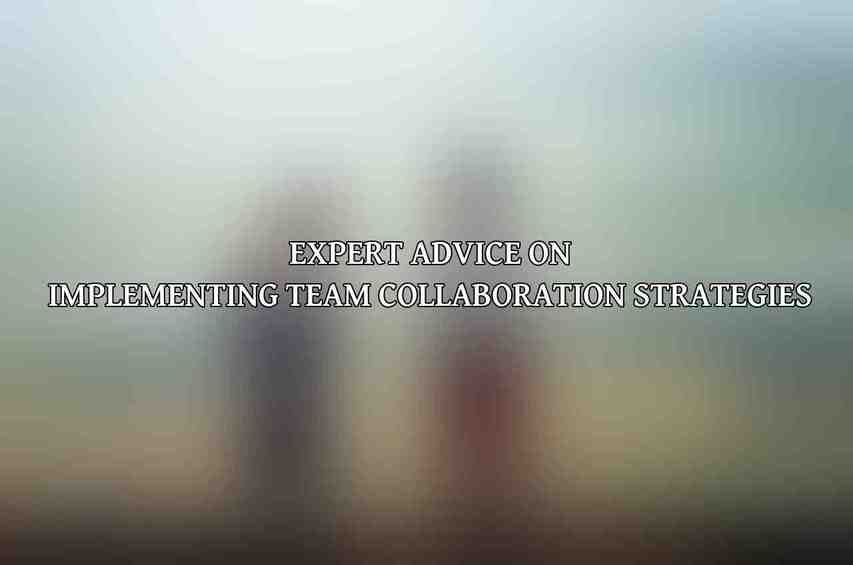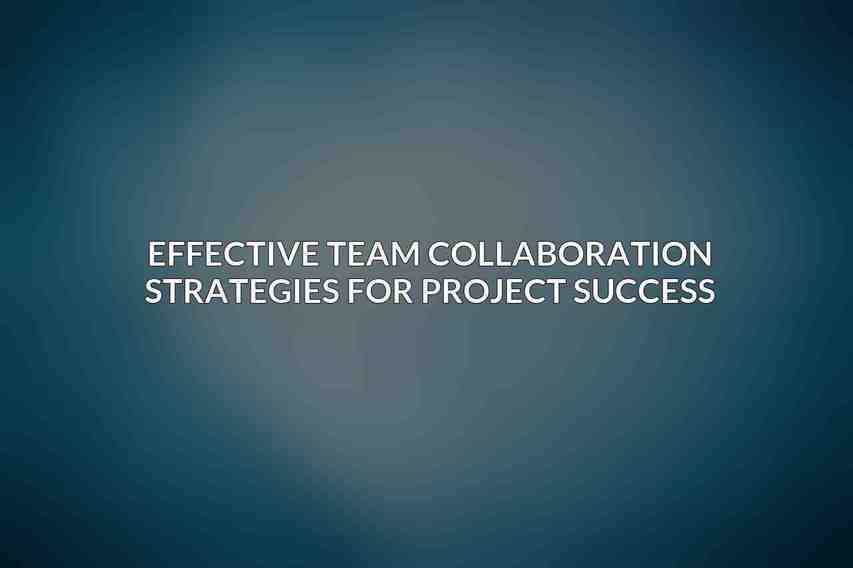Team collaboration is the process of working together to achieve a common goal or objective. It involves individuals pooling their skills, knowledge, and resources to accomplish tasks efficiently and effectively. Effective team collaboration is essential for the success of any project, as it fosters synergy among team members and enhances overall productivity. The benefits of effective team collaboration are numerous and can have a significant impact on project outcomes.
Definition of team collaboration
Team collaboration is the act of individuals coming together to collectively work towards a shared goal. It involves cooperation, communication, and coordination among team members to achieve desired results.
Benefits of effective team collaboration
- Improved communication: Clear and open communication among team members ensures that everyone is on the same page, reducing misunderstandings and errors.
- Enhanced productivity: Collaborative efforts often lead to increased efficiency and productivity as team members leverage each other’s strengths and skills.
- Increased innovation: By fostering a collaborative environment, teams can generate creative ideas and innovative solutions to challenges.
- Improved problem-solving: Collaborative problem-solving allows for diverse perspectives and expertise to be considered, leading to more effective solutions.
- Stronger team relationships: Collaboration builds trust and rapport among team members, creating a cohesive and supportive work environment.
Core Team Collaboration Strategies
Effective team collaboration is supported by a set of core strategies that facilitate communication, alignment, decision-making, conflict resolution, and continuous improvement within the team.
Communication and Information Sharing
- Establish clear communication channels: Define how and when communication will occur, whether through meetings, emails, or project management tools.
- Use a variety of communication tools: Utilize tools such as messaging apps, video conferencing, and collaborative platforms to ensure effective communication.
- Foster an environment of open and honest communication: Encourage transparency and feedback among team members to promote trust and understanding.
- Implement project management software: Use tools like Trello, Asana, or Slack for document sharing, task management, and real-time collaboration.
Goal Alignment and Planning
- Define clear project goals: Establish SMART (Specific, Measurable, Achievable, Relevant, Time-bound) objectives that align with the project’s overall vision.
- Develop a shared understanding of team roles: Clarify each team member’s responsibilities to avoid confusion and enhance accountability.
- Create a project plan: Outline tasks, deadlines, and dependencies using tools like Gantt charts or Kanban boards for better project organization.
- Use project management software: Track progress, assign tasks, and monitor milestones to ensure alignment and progress towards goals.
Decision-Making
- Encourage active participation: Engage all team members in decision-making processes to leverage diverse viewpoints and expertise.
- Use consensus-based decision-making: Strive for agreement among team members to ensure buy-in and commitment to decisions.
- Implement a decision-making framework: Establish clear guidelines for decision-making to promote consistency and efficiency in the process.
Conflict Resolution
- Address conflicts promptly: Deal with issues as they arise to prevent escalation and maintain a positive team dynamic.
- Use conflict resolution techniques: Practice active listening, empathy, and collaborative problem-solving to resolve conflicts constructively.
- Foster a culture of respect: Cultivate a work environment where differences of opinion are valued, and team members treat each other with respect and understanding.
Continuous Improvement
- Regularly evaluate team performance: Assess team dynamics, outcomes, and challenges to identify areas for improvement.
- Implement changes: Make adjustments to processes, communication strategies, or team structures based on feedback and evaluations.
- Use feedback mechanisms: Gather input from team members through surveys, retrospectives, or one-on-one discussions to inform continuous improvement efforts.
Real-World Examples of Effective Team Collaboration

Case Study 1: Google’s “Project Aristotle”
Google conducted a study known as “Project Aristotle” to understand the dynamics of successful teams within the company. The study revealed that psychological safety, dependability, structure, clarity, and meaning were key factors contributing to team effectiveness. Google implemented strategies such as fostering a culture of open communication, providing clear goals, and promoting psychological safety among team members. As a result, teams demonstrated higher levels of innovation, productivity, and satisfaction, leading to improved project outcomes.
Case Study 2: IBM’s “Watson Health” Team
IBM’s “Watson Health” team was tasked with developing innovative healthcare solutions using artificial intelligence and data analytics. The team faced challenges related to cross-functional collaboration, complex technology integration, and tight project timelines. To address these challenges, the team implemented agile methodologies, cross-functional workshops, and regular progress reviews to enhance collaboration and communication. These efforts resulted in the successful development and deployment of healthcare solutions that improved patient outcomes and operational efficiency.
Expert Advice on Implementing Team Collaboration Strategies

Tips for Leaders
- Create a culture of collaboration: Lead by example and foster a work environment where collaboration is encouraged and valued.
- Provide clear leadership: Offer guidance, direction, and support to ensure that team members understand their roles and responsibilities.
- Facilitate communication: Establish channels for open dialogue and decision-making to promote transparency and trust within the team.
- Support collaboration efforts: Acknowledge and reward collaborative behaviors to reinforce a culture of teamwork and mutual respect.
Tips for Team Members
- Practice active listening: Pay attention to others’ viewpoints, ask clarifying questions, and show empathy in your interactions.
- Share information openly: Contribute ideas, updates, and feedback transparently to keep the team informed and engaged.
- Collaborate on problem-solving: Work together to address challenges, brainstorm solutions, and make decisions collaboratively.
- Provide constructive feedback: Offer feedback in a constructive and respectful manner to help teammates improve and grow professionally.
effective team collaboration is crucial for project success as it promotes communication, productivity, innovation, problem-solving, and relationships within the team. By implementing core collaboration strategies, organizations can optimize teamwork, drive project outcomes, and foster a culture of continuous improvement. Real-world examples like Google’s “Project Aristotle” and IBM’s “Watson Health” team demonstrate the impact of collaboration on project success. Leaders and team members can benefit from expert advice on implementing collaboration strategies to enhance team dynamics and achieve shared goals. Moving forward, prioritizing and investing in team collaboration is essential for organizations looking to thrive in a fast-paced and competitive business environment.
Frequently Asked Questions
What are the benefits of effective team collaboration in project success?
Effective team collaboration leads to improved communication, increased productivity, better problem-solving skills, and a higher likelihood of meeting project deadlines and goals. Dive deeper into Guide to Building a Strong Collaborative Team Culture
How can team members improve communication within a team?
Team members can improve communication by actively listening, being clear and concise in their messages, providing regular updates and feedback, and utilizing various communication tools such as chat platforms or project management software.
What are some common obstacles to effective team collaboration?
Some common obstacles to effective team collaboration include poor communication, conflicting goals or priorities, lack of trust among team members, unclear roles and responsibilities, and cultural differences.
How can team leaders promote a collaborative environment within their teams?
Team leaders can promote a collaborative environment by setting clear goals and expectations, fostering open communication and feedback, encouraging teamwork and mutual support, and recognizing and rewarding team achievements.
What are some effective strategies for resolving conflicts within a team?
Some effective strategies for resolving conflicts within a team include addressing issues promptly, encouraging open and respectful dialogue, seeking to understand different perspectives, finding common ground, and working towards a mutually beneficial solution.

